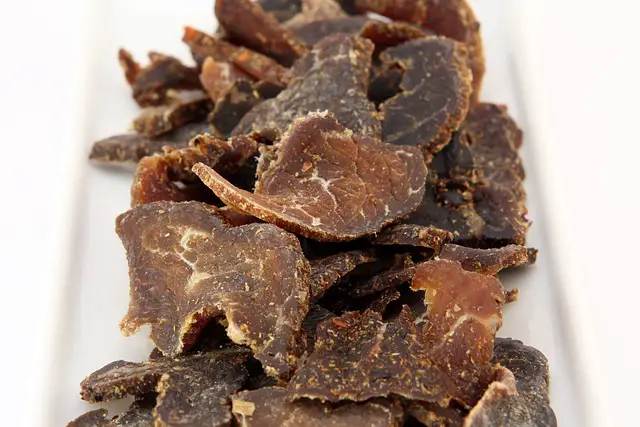Making biltong at home is a rewarding practice but with a few start-up costs. If you’re on a budget or have limited space, the best situation would utilise the equipment you already have. Many people who own dehydrators consider the possibility of multi-purposing rather than buying a biltong drying box. So, can you make biltong in a dehydrator?
Generally, you can make biltong in a dehydrator if the temperature is low enough to ensure the meat is dried rather than cooked. While dehydrating biltong is not the traditional method, it is still technically biltong, but be aware it won’t be quite as good.
The two factors that make biltong ‘biltong’ are, curing and, for this topic, the drying process. Biltong is dry-cured meat that requires low temperatures and consistent airflow.
Biltong’s tender texture and bold flavour are acquired by slowly drying the meat over several days. If biltong is dried too quickly, it can develop a hard outer casing and a tough texture. Likewise, if the temperature is too high, the meat will cook and leave you with beef jerky.
You can use two types of dehydrators to make biltong. An ‘Excalibur Dehydrator’ (with minor adjustments) will provide the closest result to traditional biltong.
A ‘food dehydrator’ requires the meat to be much thinner and will produce biltong closely resembling biltong sticks (or stokkies in Afrikaans). This result is a much thinner, drier version of biltong that snaps when you bite into it (in my opinion, still delicious).
To successfully make biltong in a dehydrator, it needs some adjustments to the equipment (this will ensure you end up with biltong, not jerky). So if you’re convinced you’d like to try it out, we’ll discuss more on how it’s done.

Making Biltong In A Dehydrator
Utilising a dehydrator to make biltong is in a territory of sacrilege if you are discussing with biltong enthusiasts. Many South Africans would argue that dehydrator-made biltong is not biltong! But is this true?
Although it isn’t traditional, you can make biltong in a dehydrator with some minor adjustments. The technicalities that make biltong ‘biltong’ are that it needs to be dried at a low heat (around 30c) with good airflow to prevent humidity. The drying should happen slowly over several days and up to a week to ensure a tender and flavourful product.
Dehydrators’ most common uses are making dehydrated fruit and biltong’s competitor…Jerky. These products are made at high heat over several hours, which basically is slow cooking. Biltong is never cooked, if it is cooked, it simply is not biltong. For more info, here’s an article on why biltong doesn’t need heat to dry.
Biltong is a dry-cured meat that uses a process of salt curing and air drying to draw out moisture and preserve meat. If biltong is not dried slowly with consistent airflow it will not remain tender and the moisture can become trapped (this is known as case hardening). Furthermore, biltong which is dried at a high temperature loses its nutrients and flavour profile.
(Speaking of drying biltong, I wrote an article on the ways to dry biltong, which will give you even more options)
Therefore to use a dehydrator to ‘dry’ biltong rather than ‘cook’ it, you need to make adjustments for this to happen. Here are the two ways to make biltong correctly in an at-home dehydrator.

How To Dry Biltong In An Excalibur Dehydrator?
A modified Excalibur dehydrator is the closest appliance to a specially made biltong dryer. This is incredibly handy if you already have one and don’t want another box lying around the house.
To use an Excalibur dehydrator for biltong there are several steps to take;
- First, follow your chosen recipe for preparing your biltong meat to the point before hanging it to dry.
- Remove the shelves from the dehydrator; this is to create a space where you can hang the biltong vertically for drying.
- Leave one at the top for hooking the meat hooks on
- Or remove all shelves and place skewers across the top rail
- Thread your pieces of meat onto meat hooks; you can buy these or make them yourself out of wire
- Hang the pieces of meat by hooking them into the top tray in the dehydrator
- Hang the pieces spaced apart so that no meat touches each other or the bottom of the dehydrator
- Place some aluminium foil at the bottom to catch drips from the drying meat
- Turn the dehydrator to the lowest setting (30-35c) or if possible leave the heat off and just have the fan running.
- Check the meat by squeezing it after 3 days, if there is still a lot of give to the meat leave it for another 1 or 2 days. (At 3 days you can slice a piece off to taste test; if you like wet biltong it should be perfect at this point).
Using an Excalibur dehydrator at the lowest settings provides conditions similar to those in South Africa, warm and dry, perfect for biltong.
How To Make Biltong In A Food Dehydrator?
A tiered food dehydrator is the least traditional way to acquire biltong, this is because the meat needs to be sliced much thinner. A thin slice of meat will dry very quickly and all the way through which results in a jerky-like final product.
This method is still tasty and worthwhile if you want to try it. You will have biltong very similar to Biltong snap sticks (which are delicious).
- First, follow your chosen recipe for preparing your biltong meat with the following alterations:
- Cut the meat to a 1cm thickness (to help with cutting the meat, a tip is to freeze it for an hour. You will be able to slice the meat with greater ease). Also, use a very sharp knife!
- For the marination stage, you should stick to a shorter marination time (2-4 hours)
- Once the meat is finished marinating it is important to remove as much moisture as possible. Use a paper towel to pat the meat whilst ensuring not to take off the spices.
- Place the meat on the dehydrator trays. Make sure they are placed apart to allow good airflow and that no pieces touch or overlap.
- Once the dehydrator is full it is time to turn it on and adjust the settings
- Turn the dehydrator temperature to the lowest setting (this should be 30-35c)
- Also, have the fan at the lowest speed
- These steps allow for the meat to dry slowly and at low heat.
- Check your biltong every few hours until it’s dried to the consistency you like. The time will vary depending on the thickness and whether you like moist or dry biltong.
So now you have some more options for making biltong besides the traditional method. Therefore you potentially have a lot of experimenting to do! And that is the exciting and very addictive part of making biltong.
Related Posts:
- Luscious Chocolate Pecan Loaf 🍫🥮
 Craving something rich and chocolatey with a hint of crunch? This irresistible Chocolate Pecan Loaf is the answer! With a blend …
Craving something rich and chocolatey with a hint of crunch? This irresistible Chocolate Pecan Loaf is the answer! With a blend … - Cheesecake Tacos
 These Mini Strawberry Cheesecake Tacos feature a crispy graham cracker-coated shell, a rich and creamy cheesecake filling, and a sweet strawberry …
These Mini Strawberry Cheesecake Tacos feature a crispy graham cracker-coated shell, a rich and creamy cheesecake filling, and a sweet strawberry … - Homemade Strawberry Ice Cream
 This Homemade Strawberry Ice Cream is irresistibly creamy and bursting with fresh strawberry flavor, making it the ultimate spring and summer …
This Homemade Strawberry Ice Cream is irresistibly creamy and bursting with fresh strawberry flavor, making it the ultimate spring and summer …






